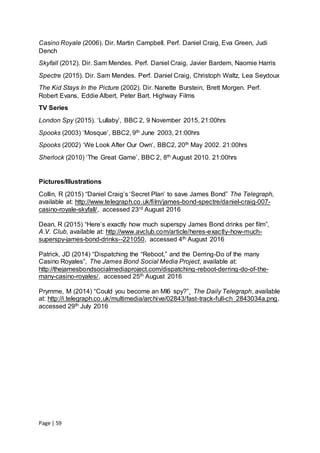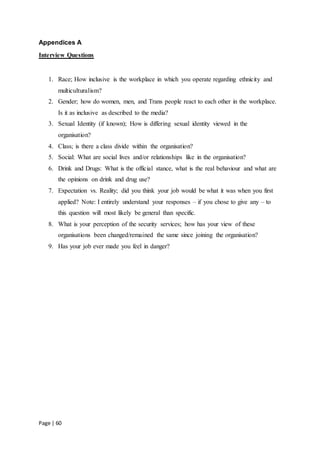This document is a dissertation submitted to the University of Bristol for the degree of MSc in International Security. The dissertation examines the media's perception of the British intelligence community compared to reality. It acknowledges popular fictional depictions like James Bond but argues these create a false narrative. The dissertation will examine the theoretical basis for this discrepancy, compare expectations to reality, and analyze why the intelligence community supports some inaccurate media portrayals. It provides context on the history and roles of British intelligence agencies like MI5 and MI6 and how their image has changed over time and due to events like 9/11.
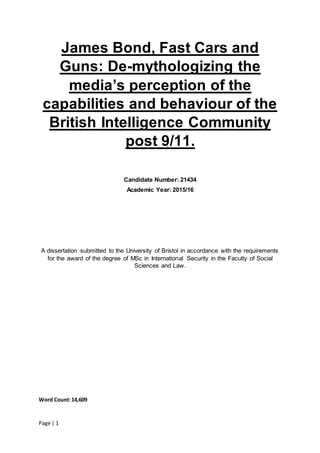


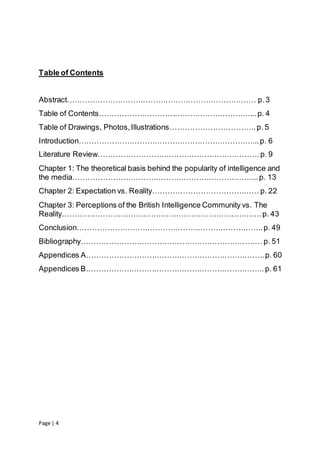

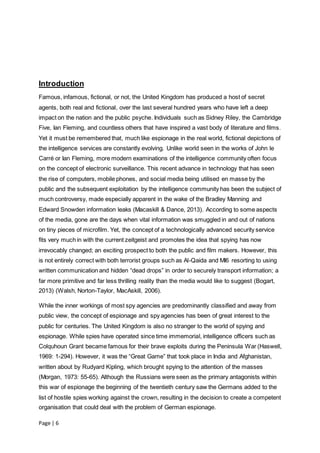

![Page | 8
lack of a fictional representative in the media and the highly secretive nature of the
organisation’s work has led to the growth of a sinister reputation. The recent scandals
involving whistle-blowers Edward Snowden and Bradley (now Chelsea) Manning have thrust
GCHQ into the spotlight, causing controversy within the British public as to the organisations
intentions (Russon, 2015).
As the Cold War came to a close, both agencies diverted their attention towards counter
terrorism and fighting international crime. In some instances, SIS officers found themselves
working with former Soviet adversaries in this endeavour, as opportunistic criminals
attempted to sell narcotics and weapons to whomever would buy them. (Grey, 2015: 1-85)
(Corera, 320). Now left without an ideological enemy, the media and films swiftly turned their
attention to the rise of free-lance criminals, mercenaries, and the like while promoting the
concept that Russia was no longer a sinister threat to western security. However, as the
1990’s wore on, more attention was devoted towards areas in the Middle East such as
Libya, Afghanistan, and Iraq, although still largely focusing on counter terrorism and criminal
activities. MI5 was also still allocating significant resources to combating the IRA. While the
Good Friday Agreement in 1998 largely neutralised the threat of the IRA, the 9/11 terror
attacks prompted British intelligence to focus the majority of their work towards fighting
global jihad in support of the US led “Coalition of the Willing” (BBC, 2016).
While the British were enthusiastic to provide support, relations between the CIA and the
British Intelligence community that had once been friendly were soured by the actions of
Vice President Cheney and Secretary Donald Rumsfeld. The two politicians, who in an effort
to find evidence of WMD in Iraq, claimed that the CIA were being disloyal when the agency
failed to find politically acceptable evidence. (Blumenthal, 2006: 27-30). The Bush
administrations’ fondness for pushing through extreme legislation such as the P.A.T.R.I.O.T
Act and vocally demanding intervention prompted the former head of SIS to state:
“The problem was the [Vice-President Dick] Cheney crowd was in too much of a
hurry, really. [And President] Bush never resisted them quite strongly enough”
(Suskind, 2008: 193)
The subsequent mishandling of the conflicts in Afghanistan and Iran as well as subsequent
terror attacks in Madrid, London, and Glasgow resulted in the British intelligence community
looking for both home grown terrorists and jihadists who had travelled to training camps
abroad. The bungled shooting of Jean Charles de Menezes and the subsequent cover-up
caused a scandal for the police and intelligence services, damaging the agencies
reputations (Hughes, 2008). The public trust in the agencies was further damaged by the
revelations of mass surveillance in 2013 (Hopkins, 2013). This lack of trust in the intelligence](https://image.slidesharecdn.com/0e92b893-4e51-440f-ace7-c37a16ef1989-161207190831/85/Completed-Msc-dissertation-8-320.jpg)





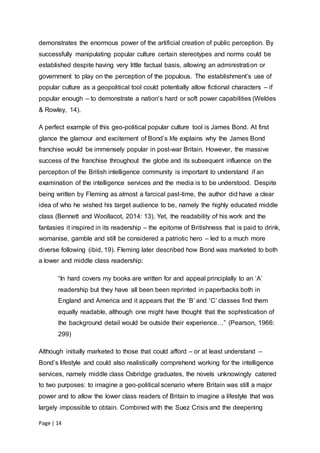
![Page | 15
tensions of the Cold War this resulted in Bond becoming, initially at a national level,
an extremely popular figure (Bennett and Woollacot,19) (Denning, 56-57). However,
it was largely thanks to President Kennedy claiming that the Bond novel “From
Russia, With Love” (1957) was his favourite fictional work that led to the series
gaining serious international fame (Booker, 1969: 179). The period of international
change that marked the United States’ ascendency to power in place of Britain as
well as the cultural evolution that was taking place was instrumental in creating the
climate that Bond would inhabit and grow famous in.
The character of James Bond, when examined from a theoretical approach, is
fascinating to examine not only from a psychological point-of-view but also from an
IR theory perspective. Firstly, the foundations of why the character still appeals to
modern audiences is complex. Written by a man who spent only six years in
intelligence during WWII and had not seen active combat, Fleming created a
character that had seen combat, was a veteran in the intelligence field, and operated
almost exclusively against communist advisories (Rankin, 2011: 1-416). While not
unusual traits to see in an action hero written in the early 1950’s, the environment
that Bond inhabited now is seemingly long gone. Clopton writes that in the formation
of identity
“[E]stablishing identity is a process in relation to other identities which is
dynamic in nature. The logics of equivalence and difference are called upon in
this process of relational identity formation” (Clopton, 2014: 9)
However, despite the radical geo-political shift that both East and West have
undergone since Perestroika Bond has still retained his relevance. David Cannadine
considers Bond to be the perfect example of examining real world geo-politics with
IR theory, writing:
“[T]he Bond corpus provides many opportunities for considering aspects of
the popular perception of the world of intelligence, for example the stress on
covert operations and on human intelligence, rather than on signals
operations. Furthermore, both novels and films drew on current fears in order
to reduce the implausibility of the villains and their villainy, while they also
presented potent images of national character, explored the relationship
between a declining Britain and an ascendant United States, charted the](https://image.slidesharecdn.com/0e92b893-4e51-440f-ace7-c37a16ef1989-161207190831/85/Completed-Msc-dissertation-15-320.jpg)

![Page | 17
fictional spy is most often gendered as male, the covert aspect of espionage involves
traits often seen as feminine such as disguise and dissimulation, while spies are
masculinised as observers and agents. The spy is therefore seen as hermaphrodite
figure within popular culture, destabilising the status quo of gender identity and
becoming highly subjective” (White, 2007: 2)
Rather than a love struck secretary as portrayed in the earlier Bond canon, the re-
imaged character of Eve Moneypenny first seen in Skyfall (2012) is entirely alien
from how the character was originally written. John Sutherland argues in the original
Bond stories:
“[T]hat the ideologies of sexism and imperialism are inscribed within the very
form of the Bond novels… As the relations between Bond and the villain and
between Bond and the girl develop and move towards their resolution, a
series of collateral ideological tensions is thus simultaneously worked through
and resolved. It is in this way that the Bond novels achieve their ‘ideological
effect’ – the effect, figuratively speaking, of placing the women back in
position beneath men and putting England back on top” (Sutherland, 1978:
176)
Yet, it is only recently that this dynamic has begun to change in the Bond films.
Hosack writes in regards to the more modern portrayal of the Bond girl that:
“She [Eve Moneypenny] proves a new breed of Bond Girl. She fights, shoots,
and banters, each scene presenting her with a great deal of physical agency.
Although her and Bond get along in an expectedly flirtatious way, her
presence in the context of the chase scene automatically undermines Bond’s
masculine authority” (Hosack, 2015: 26)
A further revelation is that unlike the last feminine character who was a match for
Bond, Vesper Lynd, Moneypenny remains loyal to the hero and the cause which they
serve. Tincknell reports that:](https://image.slidesharecdn.com/0e92b893-4e51-440f-ace7-c37a16ef1989-161207190831/85/Completed-Msc-dissertation-17-320.jpg)

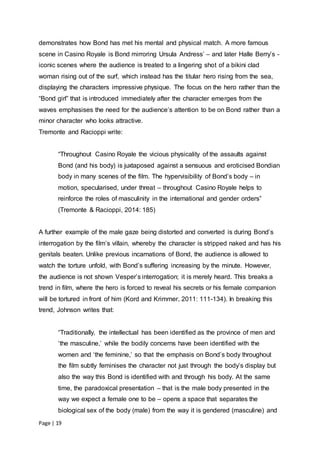


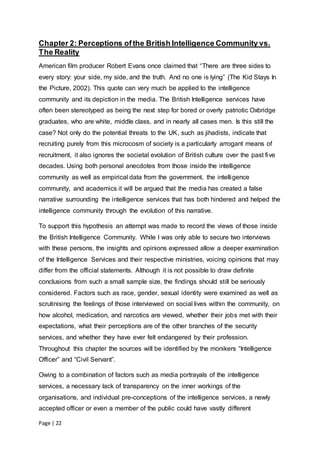
![Page | 23
expectations of how the intelligence community acts and operates rather than how it
performs in reality. Issues such as class, education, and race are often displayed in
the media as a common phenomenon however this is not always the case. In a
recent article an SIS recruitment officer complained that many potential applicants
“cancelled themselves out” because of pre-conceived notions of the environment
they would be working in (Whitehead, 2015). Another intelligence officer confessed
that originally:
“Shami, an MI5 surveillance officer, thought he never had a chance of being
recruited. He'd never been to university. ‘My understanding was that you had
to be upper class, academically bright and white male generally. I just felt I
had nothing to offer.’” (BBC, 2012)
The stereotype of the white, Oxbridge educated male has long been presented by
the media and has historical merit (Thomas, 2010: 1-479). The real Soviet agents
Philby, Maclean, Burgess, Blunt, and Cairncross were referred to as “Cambridge
Five Spy Ring” while James Bond is often fond of reminding people that he is highly
educated (Corera, 87-256). Oxford also hosts its fair share of intelligence community
recruits such as John le Carré and his literary creation George Smiley, while at least
four heads of SIS have also hailed from the university (Anthony, 2009) (Edwards,
2013). While the Intelligence community still actively recruits from these two
universities, the notion that all recruits must come from “ancient universities” is
decidedly in the flavour of the Cold War rather than in the staffing of the modern
agencies. Starting during the 1990s and far becoming the norm after 9/11 the
intelligence services began promoting the importance of meritocracy. When asked
whether class or education was still needed to progress to the upper echelons, the
Intelligence Officer remarked:
“Not that I’ve personally noticed; this may come from not having time to take
notice. Hiding behind smart attire generally blurs the lines for most… The
organisation is also very balanced. [M]y manager on paper is paid better,
higher grade, higher rank and more experienced than I’d likely attain in 10
years, yet in the meeting room we’re equals, my opinion holds equal weight,](https://image.slidesharecdn.com/0e92b893-4e51-440f-ace7-c37a16ef1989-161207190831/85/Completed-Msc-dissertation-23-320.jpg)
![Page | 24
my expertise is recognised and I feel valued as an officer for the government”
(Intelligence Officer, 2016)
Rather than the clubby quasi-nepotism that the intelligence community is often tarred
with – especially SIS – the intelligence community has seemingly learned some hard
lessons from the Cold War, namely that elitism and snobbery can be extremely
counter-productive in attempting to cultivate a loyal and able staff. The Civil Servant
also confirmed that in his experience, the “Old Boys Club” was quickly becoming
irrelevant; competence being valued more than social class or the pedigree of one’s
university. The idea of meritocracy, while seen in the media is still often paired with
the level of the character’s education.
Another misconception of the British intelligence community is possibly the most
infamous; the licence to kill. Although liberally employed by James Bond and at his
discretion, the ability to assassinate does rarely fall into the remit of the British
Intelligence Services. All British intelligence organisations are required to operate
within British law which precludes assassination, however Section 7 of the
Intelligence Services Act 1994 allows the Foreign or Home Secretary to give
clearance to any British intelligence service to act in an illegal manner. Despite this
ability to potentially kill anyone considered a threat to the security of the nation, this
power has supposedly been looked upon with derision by members of the
intelligence community. Speaking in regards to frequent rumours of planned
assassinations, former Director General of SIS Richard Dearlove denied any claims
that the service had ever ordered or used assassination for their own ends. He
further asserted that in his 38 years in SIS he had never heard of an assassination
being ordered (Allen, 2008). Morten Storm, a former spy for SIS and MI5 reported
that a British intelligence officer whom he worked with specified that:
“We [MI5] do not involve ourselves in encouraging people to participate in
jihad and we don’t involve ourselves in killings abroad. Our objective is to
gather intelligence.” (Gardham, 2012)
This is a far cry from James Bond who historically was required to assassinate two
people before being confirmed for Double-0 status (Casino Royale, 2006). If the rest
of the Double-0 section is taken into account, then at least twelve different people
have been assassinated by British intelligence in the rebooted James Bond universe](https://image.slidesharecdn.com/0e92b893-4e51-440f-ace7-c37a16ef1989-161207190831/85/Completed-Msc-dissertation-24-320.jpg)

![Page | 26
“[W]e bring a very human approach to gathering secret overseas intelligence,
our work is all about people. This is a place where qualities like creativity,
insight, curiosity, empathy and intuition are valued just as highly as intellectual
ability and analytical, logical thinking. We’re a team with a passion for global
affairs and other cultures, countries and languages – and a fascination with
human nature” (Mumsnet, 2016)
While it is apparent that the exotic life of James Bond is unrealistic, it is also equally
clear that unlike the almost nonentity that is George Smiley, modern officers will
have distinctive personalities. The Civil Servant remarked that he was surprised at
how normal the intelligence officers he interacted with were, claimed:
“I found it the same as dealing with anyone else, really... We’ve worked
together as part of a team, sometimes there are things that can’t be said but
as long as you understand the working boundaries there hasn’t been an
issue” (Civil Servant, 2016)
Former intelligence officer Harry Ferguson also confessed that unlike the almost
infallible fictional counterparts certain personality flaws can improve other aspects of
an officer’s behaviour:
“There is no ‘spy type’ that secret service recruiters look for. They look for
independent, self-driven people, who do not fit into a particular pigeonhole.
You would be laughing if you could look around a room, point and say: ‘That's
the type, that's the person.’ The idea is that you get as many reasonably
intelligent and varied men and women into the job as possible… I can forget
people's names two minutes after being introduced to them, but I retain a lot
of seemingly unimportant details which can be terribly important when dealing
with a mass of paperwork on your desk or when you are out in the field trying
to remember what your brief was” (Jenkins, 2014)
The overall perception and reputation of the intelligence community by the general
public can therefore be seen as glaringly inaccurate, exacerbated by the pre-existing
expectations made popular by the media.](https://image.slidesharecdn.com/0e92b893-4e51-440f-ace7-c37a16ef1989-161207190831/85/Completed-Msc-dissertation-26-320.jpg)

![Page | 28
With the evolution of British society, race and ethnicity have become increasingly
important factors in the British Intelligence Community. While originally seen as
passively racist organisations, the decline of the IRA and the aftermath of 9/11 saw
an epiphany ripple through the British Intelligence Services. British concerns towards
Russia the subsequent rise of China have further resulted in a remarkable shift in
attitude. The head of recruitment for SIS stated back in 2008:
“After its [SIS’s] ‘rather comfortable cold war existence’, the agency faced
different threats, which required it to be "more flexible, more adaptable". That,
he said, required people from more diverse backgrounds” (Norton-Taylor,
2008).
It cannot be denied that all three branches of the Intelligence Community have made
a concerted effort to improve their combined attitudes towards race and ethnicity. On
the website of SIS careers fast track chart, race is shown to not be a factor during
the recruitment process (see Fig. 3), with approximately 10% of SIS staff being of an
ethnic background (Norton-Taylor, 2008). On the official website of the Security
Services, it is proudly reported that “8% [of employees] come from black and ethnic
minority backgrounds (double the percentage of ten years ago)” (Secret Service,
2016a). The Director of GCHQ has also been vocal on the subject of increasing
diversity.
“To do our job, which is solving some of the hardest technology problems the
world faces for security reasons, we need all talents and we need people who
dare to think differently and be different. We need different backgrounds,
experiences, intellects, sexualities, because it is in mixing all of those together
that you get the creativity and innovation we desperately need. As a
technology-driven agency, we have to be a vibrant workplace and welcoming
to all. Dull uniformity would completely destroy us” (GCHQ, 2016)
However, despite the claims that the Services are becoming more ethnically diverse
the process seems to be a ponderous one. While it can only be positive that the
number of MI5 employees of an ethnic background has increased, examining the
official figures as released by MI5 indicates that of a workforce of approximately four
thousand only three hundred and twenty are from an ethnic background (Secret](https://image.slidesharecdn.com/0e92b893-4e51-440f-ace7-c37a16ef1989-161207190831/85/Completed-Msc-dissertation-28-320.jpg)

![Page | 30
“Though Rimington was the first female head of any of the world’s leading
intelligence or security agencies, there is no convincing evidence that her
gender had a significant influence on her appointment… She was chosen as
DG [Director General] because there was good reason to believe she was the
best candidate” (Andrew, 774)
Although Rimington only held the post for four years, her appointment inspired Judi
Dench in her portrayal as “M” in the James Bond franchise; a role that lasted 17
years. Unlike her male counterparts who played only a brief role in the plot of the
films, Dench’s “M” is crucial to several plots, is shown to be shrewd and
dispassionate, and is seemingly the only person who understands the psyche of
Bond (Child, 2016). Similarly, in the TV show “Spooks” (2002) a variety of female
officers are seen to be acting professionally and courageously, a representation that
is more accurate than the Bond franchise with official figures showing that MI5 has
lead the way within the intelligence services with 41% of employees being women
with just under half being under 40 years old (Security Services, 2016a). Both SIS
and GCHQ have also reported increasing figures; with a staff of 2,749 SIS counts
36% of its staff as female while GCHQ has 5,564 employees of whom 35% are
female (Ross & Bowcott, 2016).
Arguably the most altered attitudes towards gender are the acknowledgment and
acceptance of transgendered people within the community. Historically, the
intelligence community has not been friendly or even acknowledged transgender
issues, with arguably the most famous cases being the French spy Charles
“Chevalier” d’Eon who fought in the Seven Years War and former MI5 officer and
whistle-blower David Shayler who are typically described as being either “colourful”
or deluded (Conlin, 2010) (Milmo, 2009). However in recent years the atmosphere
amongst those in the intelligence community has relaxed considerably. Transgender
issues are now seen by the intelligence community as being part of the LGBT
umbrella and as such is fully supported by the intelligence services. The Intelligence
Officer stressed that it is not just the younger generation that is openly accepting of
transgender person within the workforce, claiming that:
“Being against any of these core values of diversity puts you into a very small
minority; it’s genuinely refreshing to see men and woman of all ages](https://image.slidesharecdn.com/0e92b893-4e51-440f-ace7-c37a16ef1989-161207190831/85/Completed-Msc-dissertation-30-320.jpg)
![Page | 31
accepting people for who they are. Often older generations can be viewed as
closed minded to issues surrounding LGBT” (Intelligence Officer, 2016)
This attitude is seemingly reflected throughout not only the intelligence community
but also the civil service. The Civil Servant remarked:
“I have come across a few of them and it sort of hasn’t been an issue. There’s
been an acceptance towards people going through that [Gender Re-
assignment Therapy]. It’s a rare occurrence but for me it hasn’t been an issue.
‘Samuel’ became ‘Samantha’ and that was it, really” (Civil Servant, 2016)
It is interesting to note how different generations within the same profession have
adapted to the drive for inclusivity. While the younger intelligence officer was
enthusiastic about the recent change of attitude regarding the LGBT community,
despite not being part of it himself, the older civil servant - while just as accepting -
appears to do so in a very matter-of-fact way. This possibly indicates that for the
older generations within the intelligence services or government, personal issues are
largely accepted provided it doesn’t hinder that person’s ability to work effectively.
However, while transgender people have largely been accepted in the work place
there has been very little positive portrayals of transgendered members of the
intelligence community.
The evolution in thought about women and transgendered people in the intelligence
service has also prompted increased examination of male employees of the
intelligence community and their representation in the media. To explain this shift in
attitude about the male gender and masculinities Cunningham and Gabri write:
“Masculinity, therefore, is not a singular category or ideology. Rather, it is a
fluid category subject to the varieties of human interactions within differing
cultural and embodied context” (Cunningham & Gabri, 2009: 83)
With more tolerant society increasingly becoming a reality, the ways in which the
intelligence community can solve security threats by approaching solutions from
different angles can increase, the Intelligence Officer stating that “It's necessary to
bring many different ways of thinking together to stay one step ahead of the mission”
(Intelligence Officer, 2016)](https://image.slidesharecdn.com/0e92b893-4e51-440f-ace7-c37a16ef1989-161207190831/85/Completed-Msc-dissertation-31-320.jpg)



![Page | 35
“If we are out in a team we do ‘Shark Watch’; a member of the team watches
for interaction with other people and make sure nothing untoward is going on”
(Civil Servant, 2016)
Not only does this protect the officers from any subversive characters but it also
allows the Shark Watch to monitor the group’s level of discretion under the influence
of alcohol. The lack of an effective monitor in the TV series Sherlock, leads to an SIS
officer having vital missile plans being stolen from him, ultimately leading to his death
(“The Great Game”, 2010). In James Bond’s most recent forays on screen, the
agent’s legendary alcohol intake is increased again, with Bond managing to
consume 26 units of alcohol during the course of Casino Royale (2006), a habit that
is contrary to both a healthy lifestyle and discretion.
Maintaining this level of discretion at all times can put an enormous strain on the
officer’s romantic and personal relationships, even superficial ones. The intelligence
officer remarked:
“[F]rom my experience [relationships are] extremely strained, you come to
notice many senior grades are in in fact not married due to the constraints of
their job. It’s difficult to maintain relationships if you’re not local to the area
and creating a social circle is entirely impossible without lifting the lid on who
you work for… For most, life generally fits around themselves, partners and a
small selection of close long term friends. You sacrifice a lot of that for your
career aspirations” (Intelligence Officer, 2016)
The senior civil servant commented that he often found that even in the work place,
interaction with intelligence officers were awkward:
“I think they try hard, sometimes, they might over try in trying to get
themselves to appear more approachable when they don’t actually need to…
Wanting to show that they are approachable and that they aren’t hiding
behind a security cloud” (Civil Servant, 2016)
While not applicable to every intelligence officer, this behaviour is a far cry from the
socially confident and cocky James Bond, ever ready with a quip or one-liner.
Instead, those officers who try overly hard to interact normally seem to do so in the](https://image.slidesharecdn.com/0e92b893-4e51-440f-ace7-c37a16ef1989-161207190831/85/Completed-Msc-dissertation-35-320.jpg)


![Page | 38
With each service having their own remit but often having agents, threats, and
sources coincide with each other, Britain’s intelligence community has often seen
considerable acrimony between the three agencies. Historically, the early Cold War
and the period of de-colonization – whereby MI5 officers would serve in
Commonwealth Nations and SIS operatives would work in non-Commonwealth
nations – led to an unfriendly rivalry, with many in SIS considering their counterparts
to be amateurs playing at espionage. (Corera, 344). However, the end of the Cold
War and the post 9/11 world of intelligence has meant that massively increased co-
operation in thwarting terrorist threats are essential. As one officer explained:
“The nature of the world is such that we can’t operate in isolation,” he says.
“So we work very closely with MI5 [the UK’s domestic Security Service] and
GCHQ [the secret listening station at Cheltenham]. It’s that combination of
technical and human intelligence that allows us to answer the questions that
key individuals in Whitehall want to know about.” (Gardener, 2015)
The intelligence community have also assisted other nations in rebuilding or
remodelling their security services, not only in accordance with Britain’s neo-Liberal
stance but also to create willing intelligence partners who can provide cooperation
and intelligence that might not be readily available to the British. In a speech by
Stella Rimmington, she proclaimed:
“We developed links with a number of countries in the former Warsaw Pact-
once we were satisfied that democracy had taken hold and espionage against
us had ceased. Together with our sister service SIS, we provided advice and
support for the reorganised and reoriented security services, particularly to
help them establish a democratic framework for their work. We also began to
exchange information on areas where there were shared concerns - crucially
in countering terrorism” (MI5, 2016)
The decline of the Iron Curtain and the rise on non-state actors – terrorists, freelance
mercenaries, and criminals - posing as security risks would suggest that enhanced
cooperation with both international and domestic agencies would be vital to ensure
security. However, while SIS and MI5 had largely improved inter-service relations by](https://image.slidesharecdn.com/0e92b893-4e51-440f-ace7-c37a16ef1989-161207190831/85/Completed-Msc-dissertation-38-320.jpg)
![Page | 39
the time of 9/11, Annie Machon reported that not all inter-service relationships were
happy ones:
“Despite the intelligence community presenting a united front to the outside
world, culture clashes between the three agencies are commonplace. Staff on
secondment between agencies… from GCHQ to MI6 – can have a rough time
fitting into a new environment, working with colleagues who eye them with
suspicion, as the divisions jockey for power, prestige and resources within
Whitehall” (Machon, 2010).
The Security Service’s insistence on interrogating all terrorist suspects holding
British citizenship while being detained in foreign nations also caused a strain on the
relationship. Often utilising the help of other intelligence agencies that had no qualms
about torture – a practice frequently derided by SIS as highly unreliable – it was felt
by some that MI5 could damage the reputation of the intelligence community. Corera
writes:
“Paradoxically, public perception and reputation is remarkably important for
those that work in the secret world. It is precisely because they cannot talk
much about their work that they worry more about the ways it is perceived by
the public” (Corera, ibid)
The negative reputation of the security services brought about by allegations of
torture, assassination, and the sinister agendas of the various agencies has had a
dramatically negative impact on the staff of the intelligence community. The
Intelligence Officer complained that:
“My view has always remained the same, we live in a world were media will
warp and twist stories to create fear and make profit. A commonly thrown
around phrase is ‘Don’t let the truth ruin a good story’ [,] that’s the long and
short of it and within the organisation we’re trying to be as transparent as we
can to give people a glimpse of what we do. There’s largely a feeling of
frustration in regards to how we may be perceived from the outside that can
occasionally be demoralising for some. We take great pride in what we do and
some [of the public] are naive in the way they view us” (Intelligence Officer,
2016)](https://image.slidesharecdn.com/0e92b893-4e51-440f-ace7-c37a16ef1989-161207190831/85/Completed-Msc-dissertation-39-320.jpg)
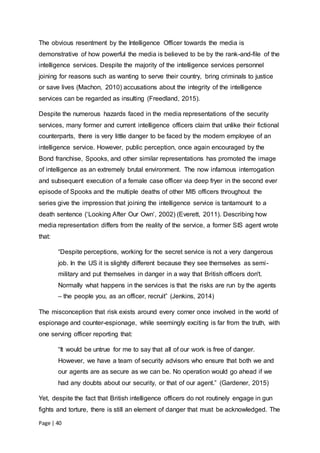
![Page | 41
Gareth Williams incident where an SIS/GCHQ officer was found dead in an
externally locked holdall – allegedly at the hands of Russian security forces –
highlights that on occasion the world of intelligence community can be extremely
hazardous (Clarke-Billings, 2015). When asked if he had ever been or felt in danger
during his career, the civil service employee reported that:
“Yes. Certainly when I first came out of the apprenticeship there was the
Northern Ireland threat which was much more than it is now… You did what
you were told and every-day you would check under the car for suspicious
looking articles that might be a bomb… Now, more recently only when
planning on going to Iraq… Generally, though with what is happening at the
moment, over the last couple of years the security levels have gone up [sic]”
(Civil Servant, 2016)
It is interesting to note that despite the highly publicised attacks carried out by
Islamic terrorist groups in recent years, the source demonstrated that they were far
more concerned about attacks when they first started working for the government in
the Thatcher era than they are currently. While efforts to maintain personal security
are still taken seriously, the perceived likelihood of an attack seemed like a distant
prospect to the source. However, for those working within the intelligence community
the potential for danger is felt much more keenly. The Intelligence Officer confessed
that:
“Dealing with the likes of criminal gangs, terrorists and similar bad people - it’s
not unusual for you to be followed, attacked, be the target of a kidnapping or
even worse. These events are infrequent and a great deal of work goes into
keeping the workforce protected but it’s important to keep your identity hidden
wherever possible” (Intelligence Officer, 2016)
The Officer continued by saying that:
“It’s not uncommon to be approached by foreign intelligence services also and
therefore travel to certain countries is prohibited unless monitored rigorously.
Regular vetting interviews are key at maintaining optimal levels of safety… I
ultimately don’t feel safe walking in and out of work but I think the threat
picture for most of Europe is very similar day to day… Feeling at potential risk](https://image.slidesharecdn.com/0e92b893-4e51-440f-ace7-c37a16ef1989-161207190831/85/Completed-Msc-dissertation-41-320.jpg)
![Page | 42
is part of what I signed up for and it doesn’t [a]ffect my work” (Intelligence
Officer, 2016)
Despite the acknowledged risk admitted by all sources, both believe that either these
risks are highly unlikely to occur or that their profession is worth taking risks for. At
no point has a comparison been made between real intelligence officers and their
more gung-ho fictional counterparts, highlighting that these events are much more
likely to occur in a CIA led operation owing to the more militarised nature of the
organisation.](https://image.slidesharecdn.com/0e92b893-4e51-440f-ace7-c37a16ef1989-161207190831/85/Completed-Msc-dissertation-42-320.jpg)
![Page | 43
Chapter 3: Why do the intelligence services actively promote
James Bond even when they publicly distancethemselves?
Despite the inaccuracies present in the majority of films and programs centred on the
main agencies of SIS and MI5, the two organisations seem to have accepted or even
encouraged these inaccuracies to continue. GCHQ, the far more secretive and less
filmed organisation, has only recently started to accept the increased attention from
the media. Notwithstanding the consistent warnings to new applicants to the service
that they will not be entering into a career remotely similar to James Bond or Spooks
and frequently dismissing any ideas to the contrary, the influence of the British spy
genre is still apparent where the depiction of espionage lies on a scale between
reality and fantasy. The waters are made darker when the official responses from the
intelligence agencies are considered. Again, owing to the sensitive nature of
espionage, an official response from any intelligence agency will have most likely
been heavily vetted beforehand, if a response is provided at all. Corera reports that
when SIS staff were given a special viewing of the James Bond film “The World Is
Not Enough” (1999), the audience cheered when an explosion rocked the building
the main character was in, apparently due to many staff disliking the new SIS
building. No official comment has yet been put forward to confirm or deny this claim
(Corera, 322).
Despite an almost universal fandom, modern commentators of the James Bond
franchise have stated that the fictional spy bears little resemblance to reality, pointing
out that the more low-key hero George Smiley is a more accurate representation of
an effective spy. This is true even for members of SIS itself, James Blitz reporting
that:
“‘The Service [SIS] has never really gone in for people like Bond,’ says one
person well acquainted with the secret world. ‘Bond is in every sense of the
word an actor. What the real SIS is all about is gathering information on
foreign governments and movements in order to face down threats in the UK.
That is a business that required silence, discretion and waiting around
endlessly in strange places’” (Blitz, 2012)
Blitz continues, reporting that:](https://image.slidesharecdn.com/0e92b893-4e51-440f-ace7-c37a16ef1989-161207190831/85/Completed-Msc-dissertation-43-320.jpg)
![Page | 44
“‘Among SIS officers, there is a greater reverence for [John Le Carre’s]
Smiley, who is in many ways the founding text,” says one former Whitehall
official. “But SIS has always been happy to assist the Bond people with their
filming.” Another former official concurs. “It is good for morale,” he says,
adding that it would not surprise him if SIS were organising a free screening of
the new film inside its Vauxhall Cross headquarters” (ibid)
While le Carré’s work has been widely read and well received, his realistically
vulnerable hero George Smiley does not have the magnetic pull that his rival James
Bond has. Despite the far more realistic tone of the novels where battles are fought
psychologically in Whitehall corridors against a similar adversary, the violence,
excitement, and women that are seen in James Bond’s missions provide a means of
escape to the bored casual reader. Despite being vastly different in both content and
style, the two spies do have some aspects in common. Both Fleming and le Carré
believed that their main characters were incredibly boring personalities, despite the
contrast between Bond’s hedonistic lifestyle and Smiley’s grey existence (Wolfe,
1987: 8). While this would not typically be a sensible decision for an author to make,
an exciting character would distract from the actual events and spying seen in the
novels (Hellman, 1962).
Yet, even at its most realistic, the events that surround James Bond are shown with
more immediacy and highlight the danger that could overwhelm the hero. Many of
Bond’s exploits in Fleming’s earlier works were directly inspired by the actions of
men in 30th Assault Unit - a small group of eccentrics, mavericks, and specially
selected officers of the British Special Forces. In “Casino Royale” (1953) Bond finds
himself battling against his adversary over a poker table, both of whom know the
other is hostile. While initially this appears fantastical, this event was inspired by an
actual occurrence to one of Fleming’s colleagues during the Second World War
(Pearson, 194-195). In comparison, le Carré’s spies are not charismatic young men
at the peak of fitness nor are they engaging in gunfights with the Soviets. Rather the
characters are more subdued and are instead described thus:
“Smiley also defies the James Bond archetype by combining in his work one
part derring-do to ten parts intellectual endeavour and one hour in the field to
fifty reading reports and files… Most of them [le Carré’s spies] have advanced](https://image.slidesharecdn.com/0e92b893-4e51-440f-ace7-c37a16ef1989-161207190831/85/Completed-Msc-dissertation-44-320.jpg)
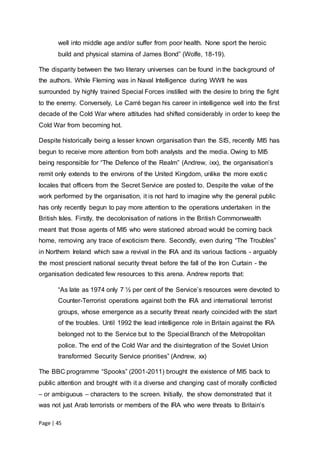
![Page | 46
internal security. Unusually for a prime-time show, every episode ended without
credits, an effort on the part of the writers to maintain an atmosphere of secrecy
throughout the show (Deans, 2002). Despite using real locations and input from then
current and former MI5 officers, the programme was far from realistic, Alan Judd
writing:
“It [Spooks] was a huge success, shaping a generation of younger viewers. It
did for the intelligence and security world what Top Gear has done for the car
industry – kept it in the public eye, indulged our fantasies, gave a lot of people
jobs and broadened the boundaries of credulity. And it entertained millions.
But it was nothing to do with spying” (Judd, 2011)
The show’s artistic licence notwithstanding, the writing team behind the show
attempted to be topical and relevant as possible, frequently authoring episodes that
were either inspired by or mentioned real world events. In 2005 the show featured an
episode where an Al Qaida cell attempted to attack London while in 2008 Russia’s
conflict in Georgia led to the Russian government being the season antagonists (The
Telegraph, 2008). However, the former head of MI5, Baroness Manningham-Buller,
has famously distanced herself from the show since the first season citing the
programme as inaccurate. She claimed that:
“I think the only thing I regret about Spooks… is one that it portrays
intelligence as simplistic, that things can be solved in 40 minutes by six
people… The second thing I regret about it is it portrays the service as having
utter disregard for the law, whereas we are very careful that everything we do
has a proper legal basis” (Irvine, 2009)
Despite this criticism the show continued to be popular and saw an increased
number of recruits attempting to join MI5 in the years that it aired, highlighting how
influential even more realistic and cynical depictions of intelligence can attract
positive attention.
Despite being arguably the most important aspect of modern intelligence gathering,
the securing and utilisation of signals intelligence or “Sigint” has been a rather low
key counter-part to the other two branches of British Intelligence. Supposedly lacking
the glamour and intrigue that often permeates the perception of the agencies
dedicated to collecting “Humint”, GCHQ has nevertheless played a vital role in British](https://image.slidesharecdn.com/0e92b893-4e51-440f-ace7-c37a16ef1989-161207190831/85/Completed-Msc-dissertation-46-320.jpg)
![Page | 47
intelligence gathering, reflected in having a “larger staff than MI5 and SIS combined
as well as enjoying the lion’s share of the secret service budget [sic]” (Aldrich, 1). For
the release of the most recent Bond film “Spectre” (2015), the typically secretive
GCHQ assisted in providing publicity for the film’s premiere, despite that part of the
villain’s plan is to utilise a GCHQ like entity to effectively hold the world to ransom,
one cyber-attack at a time. Marina Hyde explains that even when being used as an
example of villainous behaviour, the sheer popularity of James Bond will result in
interest in the organisation:
“[T]he powerful hold that Bond is axiomatically deemed to have on the British
imagination can hardly have escaped the all-seeing attentions of GCHQ. It
has become unavoidably clear over its recent outings that this movie
franchise is one of those things whose health is regarded as symbiotically
linked with that of the nation” (Hyde, 2015)
Although highly critical of both Bond and GCHQ, Hyde’s claim that GCHQ were
utilising Bond’s iconic legacy to automatically grab the attention of the British public
will have few detractors. A further film on GCHQ that covers the events surrounding
the Katherine Gun leak and trial is currently being filmed and promises to be critical
of the agency (Pulver, 2016). Yet, despite the awesome power that both the
criminals and British intelligence supposedly have in “Spectre”, others are sceptical
of the prediction that GCHQ has a proto-fascist agenda. Fraser Nelson argues:
“Snowden’s dire warnings about a ‘system of worldwide mass surveillance’
gave the impression of our spies somehow being able to scan every email
sent. But they have neither the technology nor the permission: they’re in the
business of scanning bulk data, which is very different. This involves checking
basic details, the internet equivalent of an itemised phone bill, to see who is
contacting whom. From all of this, they look for a pattern. If they spot
something suspicious, and want to read an email or tap a telephone, they
need a warrant” (Nelson, 2015)
Much like Manningham-Buller’s complaint about “Spooks”, GCHQ is still reliant on
the British legal system in order to begin invasive investigatory procedures and is
both technically and legally unable to conduct operations like those portrayed in
“Spectre”.](https://image.slidesharecdn.com/0e92b893-4e51-440f-ace7-c37a16ef1989-161207190831/85/Completed-Msc-dissertation-47-320.jpg)










![Page | 58
Holmes, P (2016) “Stonewall Top 100 Employers: The Definitive Guide to the Most
Inclusive Employers in Britain”, Stonewall, available at:
http://www.stonewall.org.uk/get-involved/workplace/workplace-equality-index,
accessed 27th July 2016
Kaufmann, S (2010) “James Bond’s Psyche: The personality profile of the Dark
Triad”, Psychology Today, available at:
https://www.psychologytoday.com/blog/beautiful-minds/201007/james-bonds-
psyche, accessed 23rd August 2016
Mumsnet (2016) “Intelligence Officers”, Mumsnet, available at:
https://jobs.mumsnet.com/job/304937/intelligence-
officers/?LinkSource=PremiumListing&utm_source=Twitter&utm_medium=post&utm
_campaign=thread%2Bjobs%2Bintelligence%2Bofficers%2Bmi6, accessed 23rd
August 2016
Security Service (2016) “Diversity”, Security Service MI5, available at:
https://www.mi5.gov.uk/careers/diversity, accessed 29th July 2016
Security Service (2016) “Security and Democracy – Is there a Conflict?” Security
Service MI5, available at: https://www.mi5.gov.uk/news/security-and-democracy-is-
there-a-conflict, accessed: 22nd August 2016
Secret Intelligence Service (2016) “MI6 enters the top 100 in the Stonewall
Workplace Equality Index (WEI)”, Secret Intelligence Service MI6, available at:
https://www.sis.gov.uk/news/stonewall.html, accessed 29th July 2016
Secret Intelligence Service (2016) “May 17th – MI6 Proud to Support the International
Day Against Homophobia, Transphobia, and Biphobia (IDAHOT Day)”, Secret
Intelligence Service MI6, available at: https://www.sis.gov.uk/news/idahot.html,
accessed 29th July 2016
The Numbers (2016) “Box Office History for James Bond Movies”, The Numbers,
available at: http://www.the-numbers.com/movies/franchise/James-
Bond#tab=summary, accessed 17th June 2016
Interview
Civil Servant (2016) Interviewed by Michael Exton, Private Interview, 23rd July
Interview – via Email
Intelligence Officer (2016) Interview Questions [email]
Films](https://image.slidesharecdn.com/0e92b893-4e51-440f-ace7-c37a16ef1989-161207190831/85/Completed-Msc-dissertation-58-320.jpg)
